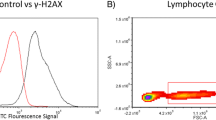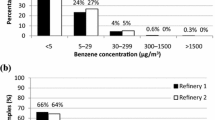Abstract
In a recent joint European research project “Biomonitoring of human populations exposed to genotoxic environmental chemicals: biomonitoring of styrene exposed individuals”, a logbook method for assessment of long-term styrene exposure was applied in two Danish factories manufacturing glass fibre-reinforced polyester. The method was based on work process identification, assignment of work process concentrations and logbook keeping. Measures of exposure calculated by this method were compared with results from simultaneous measurements of styrene in blood and the metabolites mandelic acid and phenylglyoxylic acid in urine. Correlations were comparable with those obtained by use of personal samplers as published in the literature. Styrene in blood, however, only correlated with logbook concentrations at the time of sampling. Exposures were moderate to low. Mean personal 8-h time-weighted average concentration (8hTWAC) was 76 mg/m3 styrene (SD 54 mg/m3, range 2–230 mg/m3). The Danish 8hTWAC threshold limit value for styrene in air, 105 mg/m3 (25 ppm), was exceeded on 17% of personal days. The summed urinary metabolites, mandelic acid and phenylglyoxylic acid, had a mean personal value of 138 mg/g creatinine (SD 84 mg/g creatinine) on the day of sampling. Blood styrene mean value was 129 μg/l (SD 74 μg/l, range 66–358 μg/l). It is concluded that the logbook method offers a technique for testing whether measurements are performed on representative days and may be recommended as a tool supplementary to biological monitoring in the assessment of long-term exposure.
Similar content being viewed by others
References
Ashton-Tate Corporation (1988) dBase IV, developer's edition
Atherly G (1985) A critical review of time-weighted average as an index of exposure and dose, and of its key elements. Am Ind Hyg Assoc J 46:481–487
Bowman JD, Held JL, Factor DR (1990) A field evaluation of mandelic acid in urine as a compliance monitor for styrene exposure. Appl Occup Environ Hyg 5:526–535
Brenner DD, Jeffrey AM, Latriano L, et al. (1991) Biomarkers in styrene-exposed boatbuilders. Mutat Res 261:225–236
Brugnone F, Perbellini L, Wang GZ, et al. (1993) Blood styrene concentrations in a “normal” population and in exposed workers 16 hours after the end of the workshift. Int Arch Occup Environ Health 65:125–130
Buringh E, Lasting R (1991) Exposure variability in the workplace: Its implication for the assessment of compliance. Am Ind Hyg Assoc J 52:6–13
Christakopoulos A, Bergmark E, Zorcec V, Norppa H, Mäki-Paakkanen J, Osterman-Golkar S (1993) Monitoring occupational exposure to styrene from hemoglobin adducts and metabolites in blood. Scand J Work Environ Health 19:255–63
Conover WJ (1980) Practical nonparametric statistics. 2nd ed. Wiley, New York
De Rosa E, Cellini M, Sessa G, et al. (1993) Biological monitoring of workers exposed to styrene and acetone. Int Arch Occup Environ Health 65:107–110
Droz PO, Berode M, Wu MM (1991) Evaluation of concominant biological and air monitoring results. Appl Occup Environ Hyg 6:465–474
Droz PO (1993) Pharmacokinetic modelling as a tool for biological monitoring. Int Arch Occup Environ Health 65:S53-S59
EEC project (1989) Biomonitoring of human populations exposed to genotoxic environmental chemicals: biomonitoring of styrene exposed individuals. Danish National Institute of Occupational Health CEC Contract no. EV4V-0179-DK
Gobba F, Galassi C, Ghittori S, et al. (1993) Urinary styrene in the biological monitoring of styrene exposure. Scand J Work Environ Health 19:175–182
Guillemin MP, Berode M (1988) Biological monitoring of styrene: a review. Am Ind Hyg Assoc J 49:497–505
IARC Monographs (1985) Evaluation of carcinogenic risks to humans. Allyl compounds, aldehydes, epoxides and peroxides. vol 36: 245–263. International Agency for Research on Cancer, Lyon, France
IARC Monographs (1987) Evaluation of carcinogenic risks to humans. Overall evaluations of carcinogenicity: an updating of IARC Monographs volumes 1 to 42. Supplement 7. International Agency for Research on Cancer, Lyon, France
Kivistö H, Pekari K, Aitio A (1993) Analysis and stability of phenylglyoxylic acid and mandelic acids in the urine of styreneexposed people. Int Arch Occup Environ Health 64:399–403
Long GL, Winefordner JD (1983) Limit of detection. A closer look at the IUPAC definition. Anal Chem 55:712–724
Löf A, Lundgren E, Nordqvist MB (1986) Kinetics of styrene in workers from a plastics industry after controlled exposure: a comparison with subjects not previously exposed. Br J Ind Med 43:537–543
Mandel J (1984) Fitting straight lines when both variables are subject to error. J Qual Technol 16:1–14
Mürer AJL, Molin Christensen J, Midtgaard T (1994) Determination of urinary metabolites of styrene: estimation of the method evaluation function and evaluation of reference values in Danish subjects. Int Arch Occup Environ Health 65:313–318
NIOSH (1977) Manual of analytical methods, 2nd edn. Method No.: S 127
Olsen E, Jensen B (1994) On the concept of the “normal” day. Quality control of occupational hygiene measurements. Appl Occup Environ Hyg 9:245–255
Olsen E (1994) Analysis of exposure using a logbook method. Appl Occup Environ Hyg 9:711–722
Pekari K, Riekkola M, Aitio A (1989) Simultaneous determination of benzene and toluene in the blood using head-space gas chromatography. J Chromatogr 491:309–320
Rappaport SM (1991) Assessment of long-term exposures to toxic substances in air. Ann Occup Hyg 35:61–121
Walles SAS, Edling C, Anundi H, Johanson G (1993) Exposure dependent increase in DNA single strand breaks in leucocytes from workers exposed to low concentrations of styrene. Br J Ind Med 50:570–574
Wigaeus E, Löf A, Bjurström R, Nordqvist MB (1983) Exposure to styrene. Uptake, distribution, metabolism and elimination in man. Scand J Work Environ Health 9:479–488
Author information
Authors and Affiliations
Rights and permissions
About this article
Cite this article
Jensen, B., Mürer, A.J.L., Olsen, E. et al. Assessment of long-term styrene exposure: a comparative study of a logbook method and biological monitoring. Int. Arch Occup Environ Heath 66, 399–405 (1995). https://doi.org/10.1007/BF00383147
Received:
Accepted:
Issue Date:
DOI: https://doi.org/10.1007/BF00383147




